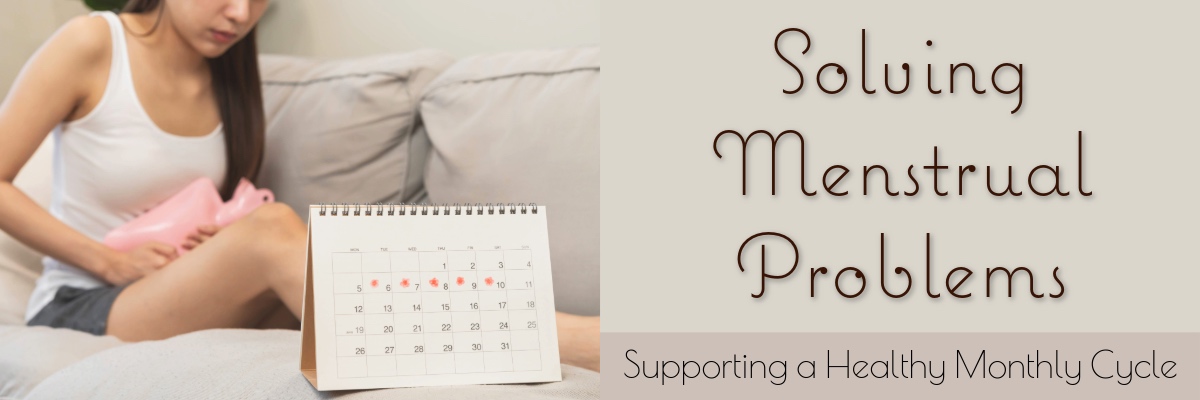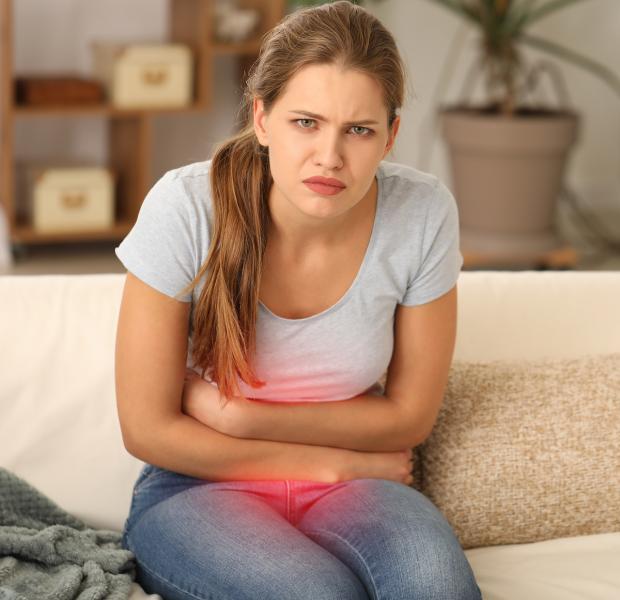
Many women suffer from needless pain or discomfort during their monthly hormonal cycle. These problems include serious pain, fatigue, headaches, bloating, and breast swelling, as well as mood disturbances including anger, anxiety, and depression. They usually occur just prior to the start of menstruation, and are collectively called PMS (pre-menstrual syndrome). Pain and heavy bleeding are also common problems that occur during menstruation.
If you experience any form of discomfort with your monthly cycle, this issue of Sunshine Sharing is for you. It will help you discover natural solutions to many of these problems. In it you’ll learn various nutrients, herbs, and lifestyle changes that can help you experience a healthy, symptom-free cycle.
Dysmenorrhea (Painful Periods)
Mild discomfort before or during a period is a common problem, with over 80% of women reporting that they experience it. Period pain is called dysmenorrhea and there are two forms. When pain occurs and there are no diseases in the female organs, the problem is labeled primary dysmenorrhea. The second type, secondary dysmenorrhea, involves additional problems like uterine fibroids, endometriosis, or adenomyosis.
Primary dysmenorrhea is common in young women and occurs because of high levels of prostaglandins secreted to make the uterus contract to help shed the uterine lining. This creates cramping and discomfort, which usually begins shortly before menstruation and lasts about three days. About 5-15% of women report the pain is so severe that it interferes with normal activities.
The standard treatment for primary dysmenorrhea is to use nonsteroidal anti-inflammatory drugs (NSAIDs) like ibuprofen or naproxen. Some women also use acetaminophen. There are some natural alternatives to these medications that can actually work better with fewer side effects. Choosing the best remedies involves identifying the type of pain involved.
It should also be noted that the use of tobacco, alcohol, and caffeine may increase the risk of menstrual pain, while regular exercise can decrease it.
 Cramping Pain
Cramping Pain
If you experience sharp, cramping pain, this is best relieved by antispasmodic herbs. Commonly used antispasmodics used for menstrual cramps include black cohosh, wild yam, cramp bark, and lobelia. Two of these remedies are natural alternatives to NSAIDs, because they are also anti-inflammatory. Black cohosh contains salicylates, the forerunners to modern aspirin, and wild yam appears to enhance the action of the anti-inflammatory hormone cortisol. Lobelia is a strong antispasmodic for easing severe cramping and is best used in doses of 5-10 drops of a tincture (or as a small part of a formula).
You should also consider taking magnesium. About 70% of the population is deficient in this mineral and a lack of it will increase the intensity of the cramping. It will also contribute to muscle tension, anxiety, nervousness, insomnia, and headaches, making it a common root cause of other PMS symptoms. If this sounds like you, try taking 200 mg. of magnesium daily and gradually increase the dose to see if it helps. You may benefit from taking up to 400-800 mg. a day, but if you start to develop loose stools, back off on the dose.
Dull Pain
If the pain you experience is dull or congestive, rather than sharp or spastic, this may be due to blood stagnation. In this case, blood movers may be helpful. Dong quai is a blood mover that is often used in Chinese formulas for supporting healthy periods. Western herbs that may also be helpful include ginger, safflowers, and yarrow. Yarrow is particularly good if there is also heavy bleeding during the period or if you have uterine fibroids.
Additional Resources
The Complete Woman’s Herbal by Anne McIntyre
Herbal Healing for Women by Rosemary Gladstar
Herbal Remedies for Women by Amanda McQuade Crawford
Women’s Herbs Women’s Health by Christopher Hobbs and Kathi Keville
Strategies for Health by Steven Horne
Become a Member
Steven Horne's monthly member program is a way for you to get great information about herbs and natural healing to build your herbal business. Including the ability to share issues of Sunshine Sharing like this one. Click here to learn more.


